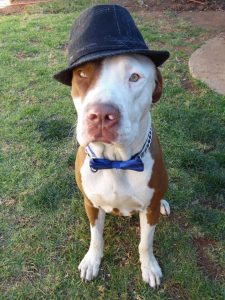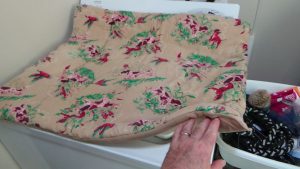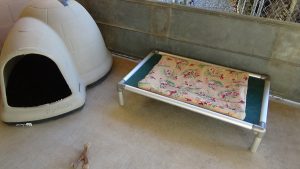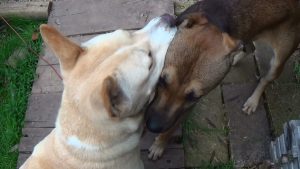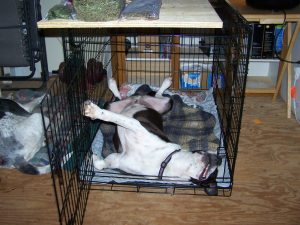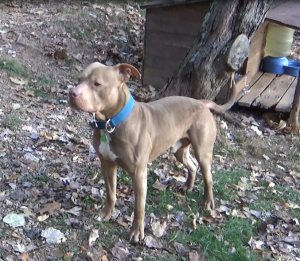 In October of 2017 we started working with a dog named Roscoe at Newport Animal Control. Roscoe is your stereotypical “pitbull”: big blocky build, bulging with muscles, square head, and a heart of gold. Roscoe lacked training of any kind, so he was enthusiastic in his bids for attention. This could be terrifying to the uninitiated, so it was doubtful that Roscoe would ever get adopted by a good home as he was.
In October of 2017 we started working with a dog named Roscoe at Newport Animal Control. Roscoe is your stereotypical “pitbull”: big blocky build, bulging with muscles, square head, and a heart of gold. Roscoe lacked training of any kind, so he was enthusiastic in his bids for attention. This could be terrifying to the uninitiated, so it was doubtful that Roscoe would ever get adopted by a good home as he was.
Roscoe came to Piney Mountain Foster for day camp sessions so I could work with him for a new program NAC had become part of called Universal K9, which trained shelter dogs, specifically “pitbulls” to be police dogs. To qualify, the dog needed to perform a series of tasks on video. Universal K9 would review the video and decide if the dog qualifies for their training. Sadly, Roscoe did not qualify. But we could not let this big handsome boy languish at Animal Control, so we took him in for fostering and began searching for a breed specific rescue that might help him find a home. While we did that we taught him some manners, house broke him, and he became part of our pack.
Another dog rescuer, I’ll call her Grandma – she will not like that but I’ll do it anyway – had visited here and fell in love with Roscoe. She has several pits of her own and loves the breed. Her daughter and son-in law were looking for a dog, and Grandma thought Roscoe would be just what they need. These young people, I’ll call them Mommy and Daddy, were about to have a child: Little One. Daddy’s work kept him away from home a lot and he wanted a watch dog to look after Mommy. Mommy wanted a companion animal. Roscoe fit both bills. They came and met him several times, then took him home. He quickly became a family member and Mommy’s protector.
When Little One was born, Grandma took the blanket that the nurses had wrapped her in after birth home and gave it to Roscoe. He was fascinated with this new scent and kept it close. When Little One came home, Roscoe already knew her and was instantly bonded to this little pink people-puppy. He instinctively knew to be gentle with her, and he became her guardian too.
I have heard several touching stories about these two and how protective and attentive Roscoe is of Little One, but I want to relate to you their latest adventure. First, you must understand that these two are inseparable. Best Buds. Little One recently learned to walk. On this particular day, Little One scampered down the hall to her room and shoved the door closed before Roscoe came in. Realizing that they were separated, and she was trapped inside, Little One began to scream. Roscoe began battering the door with his head, causing a noise that resounded through the house. Mommy came running to see what was happening. When she opened the door, Roscoe rushed in, sniffed Little One thoroughly, then checked the room. Finding all in order, he left the room leaving Mommy to deal with Little One.
Later, Little One repeated her stunt, began screaming after the door slammed, but Roscoe stayed where he was, lifted his head to look at Mommy as though to say, “She’s your kid, you deal with it this time.”
He is a devoted protector of both Mommy and Little One, but no fool.
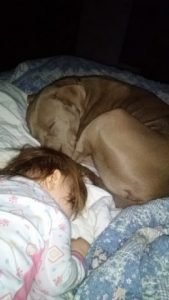 Roscoe is huge. He is a pitbull’s pitbull, and he looks formidable. But, as is typical of this breed, Roscoe is as devoted and loving of his family, and especially Little One, as can be.
Roscoe is huge. He is a pitbull’s pitbull, and he looks formidable. But, as is typical of this breed, Roscoe is as devoted and loving of his family, and especially Little One, as can be.
9/22/20, 1:26 PM
Lori sent September 22, 2020
I wanted to tell you what Dozier”AKA Roscoe did. Little one as you eloquently put it learned to open the front door and escaped while mom was in the kitchen. Dozier started crying and banging his head on the glass which of course alerted Mommy. He saved her yet again. I cannot thank you enough for this wonderful boy.
2/23/21, 8:00 PM
Lori sent Today at 8:00 PM
I wanted to thank you for Roscoe aka Dozier on 2 occasion’s he has saved Little One. Mommy woke up this morning just before 7 to Dozier raising a ruckus. My very smart and mischievous grand daughter had opened the gate to the kitchen and then the outside door. Little One was standing in the front yard in her little gown and he couldn’t get to her. This precious boy got Mommy up and let her know where Little One was. I couldn’t ask for a better guardian for my 2 year old granddaughter. Thank you for saving this beautiful boy.
A Little History
In the mid to late 1800’s Staffordshire Bull Terriers (the proper name for what is typically known as a pitbull) were known as The Nanny Dog because of their devotion to their family and especially the children. It is a true shame that greedy humans engaging in blood-sports for profit have ruined the reputation of this amazing breed of dog. Roscoe is a perfect example of what a Staffy is actually like. And we are so grateful that he was adopted into a loving family who let him fill the roll he was created to fill.
Want to help
save lives?
|
If you enjoy our updates, Doggy Tales, and educational articles consider subscri bing for notices when new pieces are posted. It’s painless and you can unsubscribe any time you want. Your e-mail address is used ONLY to deliver these notices. |
[email-subscribers namefield=”YES” desc=”” group=”Public”] |
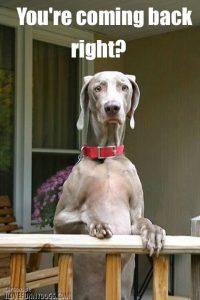 Your dog adores you. She follows you around and wants to be near you all the time. And that’s wonderful – until you must go away. Then your dog howls or barks or chews on things until you return. This is called separation anxiety. Unless you can stay home 24/7 or take the dog with you everywhere you go, you must deal with this issue (or replace a lot of shoes and furniture and endure the wrath of neighbors). To make things worse, sometimes this condition is your fault. I know: I’m guilty too.
Your dog adores you. She follows you around and wants to be near you all the time. And that’s wonderful – until you must go away. Then your dog howls or barks or chews on things until you return. This is called separation anxiety. Unless you can stay home 24/7 or take the dog with you everywhere you go, you must deal with this issue (or replace a lot of shoes and furniture and endure the wrath of neighbors). To make things worse, sometimes this condition is your fault. I know: I’m guilty too.
